#equitism
Text
By: Robert F. Graboyes
Published: May 9, 2023
There’s a move afoot to replace America’s aspirational goal of equality (equal opportunity and equality under the law) with “equity” (equal outcomes designed and implemented by elite experts). A sprawling industry has arisen to spread the gospel of equity across American life. Its catechism has been greatly assisted by an internet-wide burst of colorful little visual parables, all purporting to show the difference between the sins of equality and the blessings of equity. Google “equity,” and your screen will explode with cartoons involving baseball games, apple orchards, blackboards, bike races, street crossings, bookshelves, and more. All of these myriad representations share one identical message.
A web page at the George Washington University’s School of Public Health uses an apple tree metaphor whose lesson seems to be that if you don’t have the sense to move your ladder to the side where the apples are, it’s “inequitable” and someone should install scaffolding and cables to bend the tree toward wherever you stuck your ladder. The website then conjures up a “Magic Benefactor” to explain equality and equity. It’s magic because deserving people are “given” and “allocated” resources, apparently without anyone else required to give up those resources:
“Equality means each individual or group of people is given the same resources or opportunities. Equity recognizes that each person has different circumstances and allocates the exact resources and opportunities needed to reach an equal outcome.”
As anyone with a knowledge of history and political philosophy knows, a sizable number of countries spent much of the 20th century trying to allocate the exact resources and opportunities needed to reach equal outcomes. The results were far less than equitable. However, as any Swiss banker can tell you, the rulers of these countries did accumulate considerable equity while impoverishing their countries.
Equity folks have another visual homily, the Stadium & Fence meme, that is brilliantly clever. It’s simple, intuitive, and heartwarming. It is also naïve, misleading, and hubristic. Let’s explore this meme and nine ways in which it fails.
The Basic Stadium & Fence Meme
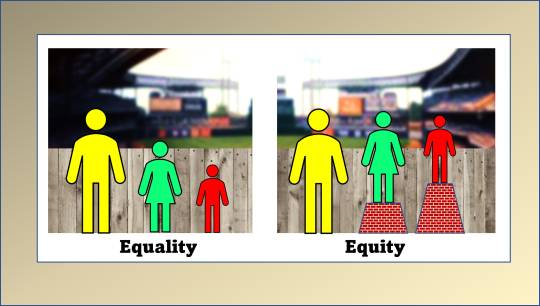
Three people—Mr. Tall, Ms. Medium, and Mr. Short are all trying to watch a baseball game over a fence. On the left, we see the odious world of equality. Mr. Tall has a clear view. Ms. Medium can barely see the field over the fence. Mr. Short cannot see over the fence at all. On the right, in the putatively just world of equity, some Magic Benefactor has allocated a small pedestal to Ms. Medium and a large pedestal to Mr. Short so all three now have equally clear views of the game. To put it another way, “To each according to his needs.”
Problem #1: “Inequality” is labeled “Equality.”
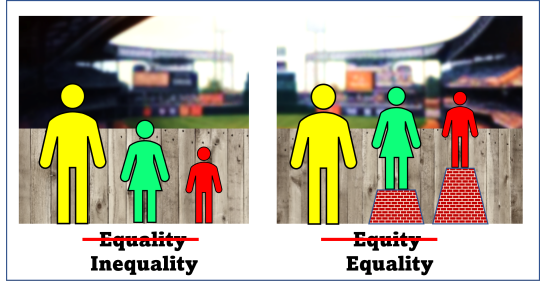
The left-hand picture doesn’t represent “equality.” An egalitarian would say that the left-hand picture represents inequality—an unfortunate but universal aspect of the human condition. The right-hand picture represents equality—a condition to which an egalitarian aspires, fully cognizant that it will never be fully realized. Bad luck, injustice, one’s starting point in life, and one’s own personal choices inevitably lead to some measure of inequality. Siblings of equal intelligence, from the same household, with identical opportunities often end up in vastly different levels of well-being. The Magic Benefactor can allocate all the resources it wants to Fredo, but he’s never going to be Michael.
Problem #2: The meme assumes an omniscient, omnipotent planner.
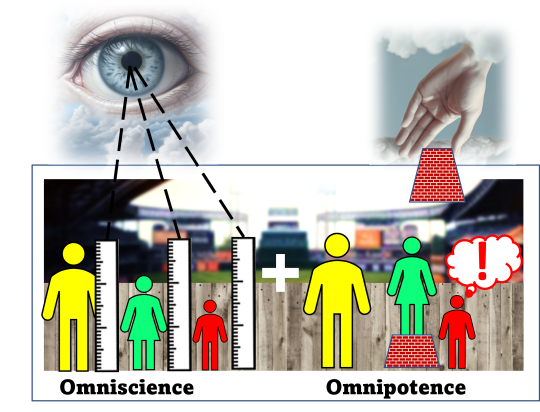
With the Magic Benefactor, individuals are helpless, passive beings, devoid of agency. Under equality, an individual is “given” resources and opportunities. Under equity, some unspecified being “allocates” resources and opportunities. In fact, these unnamed allocators are so perceptive and so powerful that they can allocate “the exact resources and opportunities needed to reach an equal outcome.” This is no Book of Job or Leibniz theodicy problem—where bad things happen to good people. Rather, it is Candide, where Dr. Pangloss always proclaims this to be the best of all possible worlds.
Problem #3: Redistribution can fail or make things worse.
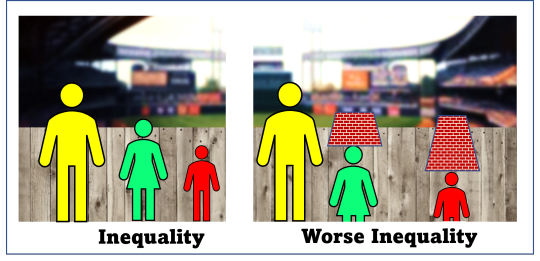
The past century was littered with redistributive schemes designed to achieve equality of outcomes and which ended in failures. There are monstrous cases, like China’s Cultural Revolution. But also benign cases, like America’s well-intended, but frustratingly ineffective War on Poverty. Central planning (i.e., allocating “the exact resources and opportunities needed to reach an equal outcome”) has a remarkable history of ineffectiveness and counterproductivity—where sincere effort to improve the lot of those at the bottom ensnares them in a poverty trap.
Problem #4: Maybe the tall guy sinks or leaves.

The Stadium & Fence and the Magic Benefactor ignore the fact that with redistribution, the reallocated resources come not like manna from Heaven, but rather from the pockets of living, breathing humans. A more realistic version of this metaphor would show Mr. Tall sinking as Ms. Medium and Mr. Short rise. Or perhaps Mr. Tall just packs up and moves away—leaving no one to pay for the pedestals for Ms. Medium and Mr. Short. This is known in governance as “eroding the tax base” and in folklore as “killing the goose that laid the golden eggs.” In the 1960s, President Lyndon Johnson’s top economic advisor, Arthur Okun, explained this phenomenon beautifully in terms of a leaky bucket.
Problem #5: Maybe those in charge have their own bigotries.
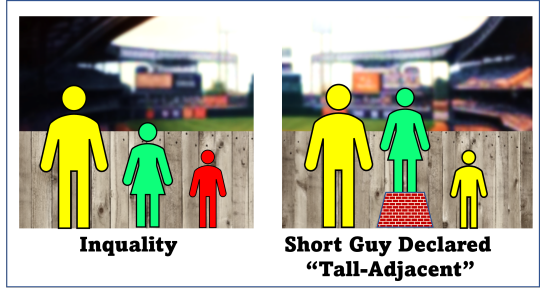
Unlike expert allocators in the Stadium & Fence and the Magic Benefactor, people in charge of real-world redistribution programs are not saintly, unbiased individuals. They come with their own collections of bigotries and deficits of introspection, all reflected in the policies they impose on others. You are disadvantaged only if the elite experts declare that you are disadvantaged. In recent years, for example, Asian-Americans, who suffered terrible discrimination over the course of U.S. history, have been declared by equity “experts” to be “white-adjacent” and, hence, on the losing side of redistribution programs. This reclassification is entirely arbitrary. Coincidentally, the apartheid regime in South Africa implemented a nearly identical redefinition of Japanese, Koreans, and Taiwanese people as “honorary whites”—for entirely cynical reasons.
Problem #6: Maybe the privileged experts in charge just use equity as a pretext to seize more privilege.

One of the more intriguing aspects of the equity agenda is that its proponents effectively say, “Governments, corporations, and educational institutions are hellholes of bigotry and discrimination—so let’s empower governments, corporations, and educational institutions to redistribute resources.” This is popularly known as, “Asking the fox to guard the chicken coop.” It is informative to note the rapidly rising salaries and numbers of equity experts employed by governments, corporations, and educational institutions.
Problem #7: Redistribution focuses on group averages, not individuals.
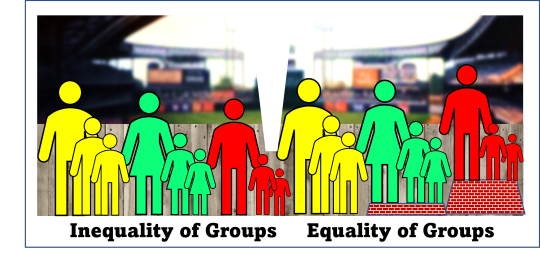
The Stadium & Fence and Magic Benefactor are both stated in terms of individuals, whereas, in reality, policies are applied to broad demographic groups. In this picture, the Talls are taller on average than the Mediums, who are taller on average than the Shorts. But there wide ranges within each category. Equity policies do not aspire to equalize individuals, but, rather, to equalize group averages. So, for example, when the pedestals are “given/allocated” to the Mediums and Shorts, the shortest member of each group, Talls, Mediums, and Shorts, is still unable to see over the fence, whereas the tallest member of the Shorts—who already had a good view of the game—now has an even better view of the game.
Problem #8: Maybe the problem is the fence, not the people.
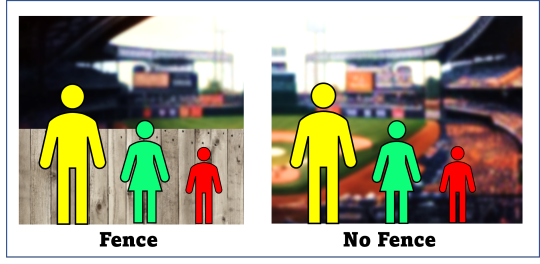
The Stadium & Fence meme never bothers to ask how the obstructive fence got there in the first place. A likely explanation is that the fence was erected by the very people with whom equity experts are entrusting with the task of reallocating resources. Access to healthcare, for example, is often impeded by government regulations that limit the number of doctors, that arbitrarily limit the scope of practice of nurse practitioners, that require hospitals to beg for permission to build new neonatal intensive care units—and enrich established insiders. Rather than obsessing over group averages on health, income, education, etc., perhaps the better approach is to rip down the obstacles that self-interested or misinformed bureaucrats and politicians and others have imposed on others.
Problem #9: Maybe the whole fence analogy is deceptive and elitist.

Finally, few, if any, have asked an obvious question that the Stadium & Fence metaphor begs: ”Why are we obsessing over equalizing viewing by three people trying to watch the game from outside the stadium?” There are two possible reasons why these three are where they are, struggling with the fence, rather than enjoying hot dogs in the bleachers with tens of thousands of other people. First, they may be victims of discrimination—excluded somehow from the stadium. If that’s the case, then equity experts are effectively saying, “It’s fine that these three can’t come into the stadium and sit next to us, but let’s make sure these second-class citizens all get the exact same inferior view of the game from the other side of the fence.” Second, perhaps these three are fully capable of buying tickets to the game but choose, instead, to peer over the fence for free. In which, case, why should anyone worry about how well any of them can steal a view of the game?
==
Unequal outcomes are not inherently unfair.
If the over-the-fence is a medical license, and height is ability to meet the requirements, then those who can't reach the top of the fence shouldn't get to see over it.
If the over-the-fence is entry to Harvard and height is test scores, then those who can't reach the top of the fence shouldn't get into Harvard. And yet, that's exactly what happened.
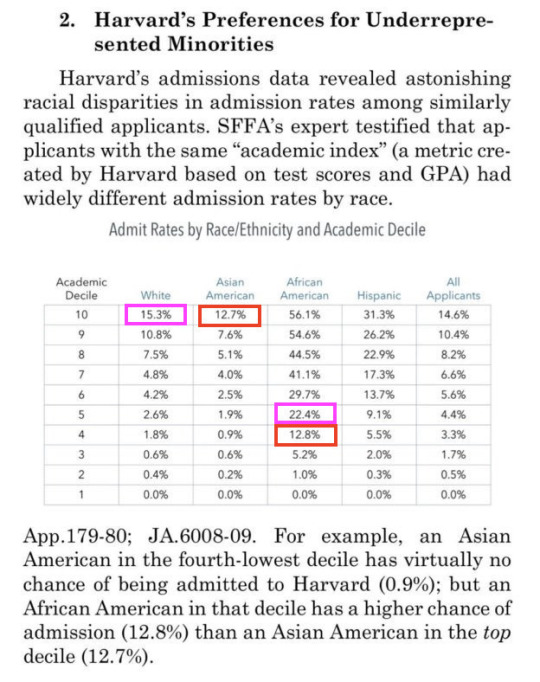
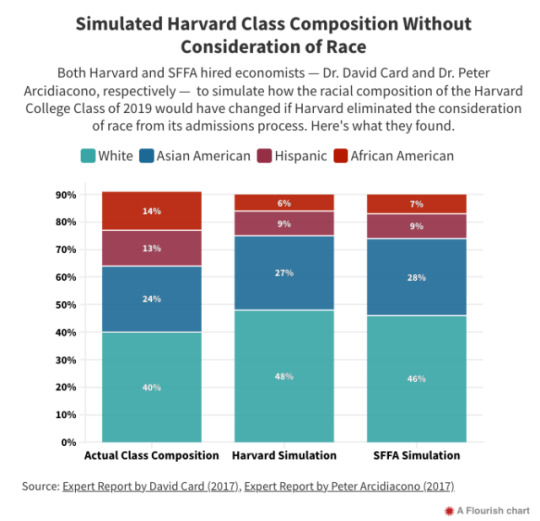
#Robert F. Graboyes#equity#equitism#equitists#equality#equality vs equity#equity vs equality#diversity equity and inclusion#DEI#DEI bureaucracy#stadium and fence meme#religion is a mental illness
9 notes
·
View notes
Text
“alt text for more info” “turn on cations for more info” no actually this is not where more info goes. These have a very distinct purpose. There are plenty of other places for more info. If you’re going to make your post inaccessible, the least you could do is not use accessibility tools at your own leisure for whatever purpose you see fit.
#disability accessibility#accessibility#vision impaired#hearing impaired#hard of hearing#physical disability#sensory disability#disability accommodations#disability representation#disability advocacy#equitability#neurodiversity#adhd autistic#disabled things#alt text#captioning#subtitles#disability resources#accessibility tools
4K notes
·
View notes
Text
youtube
This futuristic city seems interesting, but I think it might have issues locating enough water for the residents.
0 notes
Text
This is Gilberto Filipe, who dominated the World Association for Working Equitation Qualifier in Segovia, Spain, in March 2024. I think this is his Lusitano stallion Iranio.
Video from magda_konno on Instagram! Link in the comments.
#horse#equestrian#horseblr#working equitation#traditional riding#spanish riding#lusitano#stallion#horses
2K notes
·
View notes
Text

A random shot from an anti-aircraft battery, whose gunners accidentally let go with eight shells in the New York metropolitan area on March 13, 1942, hit the Equitable Building in the financial district in lower Manhattan. The shell hit the corner (center foreground), about 400 feet above the street, between the 37th and 38th floors, chipping the corner stonework just above the ledge and knocking loose a small piece of the cornice just below the ledge.
Photo: Anthony Camerano for the AP
#vintage New York#1940s#Anthony Camerano#World War II#antiaircraft#wartime mistake#Equitable Building#March 13#13 March
57 notes
·
View notes
Text
perhaps will provide more thoughts on this later but dungeon meshi is ultimately a story about societal outcasts reckoning with their internalized biases of others by reflecting on their experiences, evolving their perspectives, and building community bonds in the process and I think that is beautiful
#dungeon meshi#there is literally no real villain#everyone just learns what coexisting equitably (to an extent) means#including integration of monster ecosystems and human races
106 notes
·
View notes
Text
VRISKA: i think all les8ians should 8e legally allowed to murder people
#submission#homestuck#incorrect homestuck quotes#vriska serket#mod terezi#it's equitability is what it is
71 notes
·
View notes
Text
Doctors/surgeons should come before a panel of medical experts who are trans before being allowed to administer trans-specific care
#trans#transgender#lgbt#lgbtq#ftm#mtf#nonbinary#this is a half-joke post btw#i kind of want to go in a medical field and while i don't know the ins and outs of what training is for people of minority status...#...it's probably not the best considering how many awful doctors *i've* had...#...i genuinely think we need some reconciliation of this issue because it's unhelpful at best and irresponsible and unethical in some...#...of these cases#so the panel of transsexuals is probably a hyperbole but i think if you're a doctor doing TRANS healthcare...#...then your *trans* patients should be your top priority#again i do kind of want to enter the field and while i don't want to do trans-specific care i would still put my trans patients...#...very highly when considering how to treat patients of trans experience...#...before there is misinterpretation: no i wouldn't prioritize a trans patient over a cis one#all i'm saying is that TRANS-specific healthcare providers should be required to uphold their trans patients...#...and treat them not only well but equitably. same goes for general healthcare providers...#...but it is wild to me that you don't need to have your future patients' best interest in mind in order to enter the field...#...that should be about the FIRST thing you make sure the prospective professional has no?
553 notes
·
View notes
Text
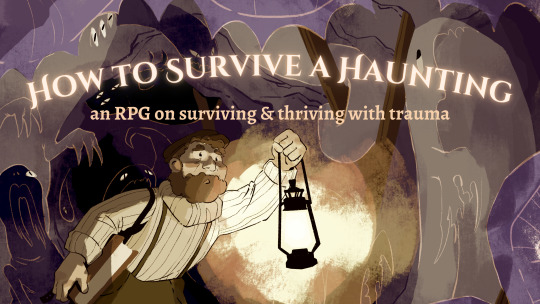
ID in alt
In How to Survive a Haunting, you play as Stranger, an entity plagued by ghosts who try to possess you, and take over your home and your life. Luckily, you have come across a mysterious old journal, written by a man only referred to as The Journalkeeper. He has spent his life studying ghosts, and made it his mission to record everything he knew about how to defend yourself from them, and how to tame them
On the journey to taming your ghosts, you will represent your accomplishments through tokens, keep a magical deck of cards that help you ward off unearthly possessions, and log your adventure in a journal. The Journalkeeper will walk you through each stage of this process, and teach you how to customize the game to fit your specific needs
Haunting is a gamified mental health aid, designed to help people learn more about how their body works, adopt a challenge mindset, and achieve post-traumatic growth. It is designed with a light horror aesthetic (though no actual scares in the game) to meet people in the mental space that they're at, and not make light of extremely difficult circumstances. It is geared towards the recovery of those with trauma and (c)PTSD
haunting is now pre-launched on kickstarter!
It is written by long-time disability advocate and social worker Luka Brave, who was inspired by his experiences with gamification and tabletop roleplaying in his journey of self-discovery and recovery. In his professional work, Luka has worked with many other avid gamers, including many who have experienced trauma, PTSD, and other life-changing mental health conditions
Haunting is currently funding to hire a psychiatric professional consultant to assist with finding reputable sources for all the science and psychology cited within the game, and make sure all the mechanics are up to date on the latest therapeutic practices
The first stretch goal is to have the game fully illustrated by the wonderful artist Vicky (@prose-n-scripts) who did the cover art seen above
Additional goals will be to sell kits with everything you need to play the game and start on your journey of recovery!
Sign up for notifications to know when the Kickstarter gets launched, and get access to many backer rewards, including a discounted copy of the finished game for marginalized folks or those living in financial hardship!
*How to Survive a Haunting is not a replacement for therapy or medication. It uses a fantasy narrative device to talk about trauma, flashbacks, panic attacks, and more. If you are prone to psychosis, magical thinking, or delusions, please approach this game with caution*
#ttrpgs#indie ttrpgs#ptsd#trauma#mental health#actually disabled#reblogs help so so much!! the team really believes in this project and we want to get it to everyone who needs it#the reward tiers are also built in with community copies so when the game goes up for sale there will be free copies for those who need it#trying to make this as equitable and accessible as i possibly can
362 notes
·
View notes
Text
By: Robert F. Graboyes
Published: Jan 28, 2024
On this, the 79th anniversary of the liberation of Auschwitz, the Holocaust Remembrance industry stands as a colossal failure. Holocaust Remembrance Day, it turns out, successfully transfixed eyes on the rear-view mirror and diverted attention from the dangers 10 feet in front of us. And, truth be told, the rear-view mirror is growing a bit foggy, as well. Less than a century ago, the leading intellectuals of Germany—the most highly educated nation on earth—initiated, participated in, or acquiesced to mass murder on a previously unimaginable scale. And only weeks ago, intellectuals in America, Europe, and elsewhere waxed lyrical over the rape, torture, mutilation, murder, beheading, and kidnapping of innocent Jews.
An important parallel underlies both historical episodes. Both Hitler and Hamas were the cancerous outgrowths of respectable and sometimes altruistic intellectual movements that saw individuals as nothing more than avatars of demographic groups, defined by immutable characteristics. At my own Substack, Bastiat’s Window, I’ve written of this in “The Briar and the Rose,” “Intellectual Tyrants Beget True Believers,” and “Zola, Weiss, and J'Accuse...! 2023.”
A century ago, eugenics provided the unquestioned and unquestionable foundation for academic writing and public policy. Eugenics preached a world of predestination, where an individual’s worth was irrevocably determined at birth by race, religion, gender, sexuality, disability, economic status, and family history. No one could escape his or her essentialist destiny by dint of action, accomplishment, or character. Eugenics began as parlor conversation among well-born, well-educated, often well-meaning British academics. Then, it jumped the Atlantic and gave rise to a sexual sterilization machine in America—enabled by a debauched Supreme Court. Finally, it leaped back to Europe, where it metastasized into the Holocaust.
In our time, the equivalent academic tendency is one that travels under many names—diversity, equity, and inclusion (DEI); critical race theory (CRT); antiracism; white fragility; intersectionality; social justice; anticolonialism; social and emotional learning; progressivism; safetyism; critical social justice; identity Marxism; and (primarily to its denigrators) “wokeness.” The central connective tenet in all of this is something called “equity”—which does not in any way resemble any traditional definition of the word.
A note on nomenclature: “equitism”
Writers like Thomas Klingenstein on the right, Freddie DeBoer on the left, and Bari Weiss in the center decry the lack of a consistent name for this intellectual and activist movement. I use the term “equitism” here and suggest it to others. Unlike “equity,” “equitism” offers no ambiguity of meaning. Unlike, say “the equity agenda,” “equitism” is a single word. Advocates of this philosophy often present “equity” as a substitute for “equality,” so “equitism” is parallel to “egalitarianism.” Unlike “woke,” “equitism” is not an insult or pejorative, and the web shows that a few advocates have used the term to describe themselves. I’ll use the term below for simplicity and clarity.
Equitism as echo of eugenics
Like eugenics a century earlier, equitism presumes that demography is destiny, with some demographic groups imperiled by the immutable malignities of other groups. This often manifests itself as a Manichaean “oppressor/oppressed” dichotomy across demographic categories. Intersectionality and other frameworks array groups along a spectrum between these polar opposites. In its most extreme manifestation, this weltanschauung justifies horrific punishment of perceived “oppressors.” Hence, the pro-Hamas marchers proclaiming “by any means necessary”—which presumably includes baking babies to death in ovens, tying parents to children and immolating them together, raping young girls till their pelvises shatter, beheading children in front of their parents, and visiting all manner of depravities upon elderly Holocaust survivors—as long as they are Israelis and Israelis are classified as oppressors.
Clearly, those Western professors celebrating Hamas have not absorbed whatever lessons that Holocaust Museums were designed to impart. To name one category of protestors, LGBTQ+ Jews marching for Hamas seem not to understand the message of Martin Niemöller. The most enthusiastic practitioners of Holocaust Remembrance, unfortunately, seem to be the members of Hamas, who learned the lessons of those years all too well. It should noted that David Patterson’s 2022 scholarly work, Judaism, Antisemitism, and Holocaust: Making the Connections, documents Hamas’s literal organizational and philosophical links to Hitler’s Nazis.
The central feature of both the Holocaust and of Hamas’s slaughter is that once one abandons the sanctity of individuals and considers only the presumed virtues and vices of demographic groups, one is free to attack those deemed unvirtuous in any way.
Furthermore, equitism, like eugenics, can anesthetize those who do not share the murderous intentions of the Nazis or Hamas. The United States Holocaust Memorial Museum has been open for 31 years, but its mission clearly failed to educate the Ivy League presidents who hemmed and hawed and equivocated over questions of whether calls for genocide against Jews qualified as protected speech on the same campuses where subjectively discerned microaggressions or misuse of preferred pronouns are grounds for ostracism and punishment.
Who wants to contradict something called “social justice” or “diversity” or “equity?” The anesthetic effect seems to have impacted even the Holocaust museums themselves. At Commentary magazine, Seth Mandel asked, “Why Are Holocaust Museums Cowering in Silence?”
Corrosion begins in microscopic proportions
The most important lesson for Holocaust Remembrance comes from Dr. Leo Alexander’s simple, chilling statement that “corrosion begins in microscopic proportions.” Alexander, an American psychiatrist, neurologist, educator, and author, of Austrian-Jewish origin, was a key medical advisor during the Nuremberg Trials. He wrote part of the Nuremberg Code, which provides legal and ethical principles for scientific experiment on humans, and discovered that German doctors didn’t fail to stop the Nazis’ program of genocide and barbaric medical experimentation. Rather, he discovered they didn’t do more to stop the horrors because they were instrumental in initiating them. In a 2018 article on this subject, I argued that:
German doctors enthusiastically volunteered for [service] to, and leadership within, the Third Reich. Deputy Fuhrer Rudolf Hess declared Nazism ‘nothing but applied biology,’ and many German doctors apparently agreed.” Collectively, they decided that medicine’s primary purpose was to build “an economically productive populace,” a concept that “opened the floodgates for atrocities.”
By contrast, Alexander found that Dutch physicians following the Nazi conquest of the Netherlands, unanimously rejected this assumption and viewed their role as healing and comforting the sick and dying. Even when threatened with punishment and death, “humility assured that no Dutch doctors participated in the Holocaust.
German doctors, besotted with eugenics, gladly segmented society by ethnicity, by disabilities, by sexuality, and so forth. And once they began thinking of groups (e.g., productive versus nonproductive races), rather than of individuals, then they were free to commit atrocities in good conscience—or at least to acquiesce in the atrocities committed by others. The same dynamic plays out today on the campuses of America or the streets of London and Paris and Sydney.
Alexander’s work is described in James A. Maccaro’s brief 1997 article “From Small Beginnings: The Road to Genocide.” Alexander’s full paper is his 1948 New England Journal of Medicine report on “Medical Science Under Dictatorship.” A century ago, the oxidants that began society’s corrosion lay in eugenics. Today, the oxidants lie in equitism.
In the early 20th century, eugenics was almost universally accepted by academicians, politicians, doctors, the general public, and celebrities. Opposing eugenics put one’s career and friendships in peril. One of the few public intellectuals to oppose this madness was the British writer G. K. Chesterton, author of Eugenics and Other Evils (1922). Chesterton understood better than anyone that evil comes most often not from evil people, but rather from good people with unmoored ethics. In 1908, he wrote:
The modern world is not evil; in some ways the modern world is far too good. It is full of wild and wasted virtues. When a religious scheme is shattered (as Christianity was shattered at the Reformation), it is not merely the vices that are let loose. The vices are, indeed, let loose, and they wander and do damage. But the virtues are let loose also; and the virtues wander more wildly, and the virtues do more terrible damage. The modern world is full of the old Christian virtues gone mad. The virtues have gone mad because they have been isolated from each other and are wandering alone. Thus some scientists care for truth; and their truth is pitiless. Thus some humanitarians only care for pity; and their pity (I am sorry to say) is often untruthful.
Holocaust Remembrance Day is a worthy project, but not if it is solely backward-looking. Looking for Nazis in 2024 is a futile endeavor. Scanning the horizon in front of us for those with parallel intent is far more urgent and challenging.
As goes the aphorism, “History doesn’t repeat itself, but it rhymes.”
#Holocaust Remembrance Day#Holocaust Memorial Day#Holocaust Remembrance#Auschwitz#Robert F. Graboyes#antisemitism#equitism#woke#wokeness#wokeism#cult of woke#wokeness as religion#Substitution Hypothesis#eugenics#Third Reich#religion is a mental illness#International Holocaust Remembrance Day
7 notes
·
View notes
Text
Some people will get soooo offended if you say they are privileged ???what’s the deal with that
privileged=undeserving? it’s morally ambiguous?? privilege=malice??? evil intent?? no!
#they’ll be like ‘I didn’t ask to be rich/abled/skinny/white/etc’ okay and????#still a privilege lol not sorry#so goofy#silly even#goober behavior#pretty privilege#male privilege#thin privilege#privilege#social justice#social equity#equitability#solidarity#intersectional social justice#intersectionality#intersectional activism#intersectional feminism#neurodiversity#disability#racial justice#economic justice#power dynamics#oppression#colonization#reparations#allistics#neurotypicals be like#straight people#cisgender#cisheteronormativity
202 notes
·
View notes
Text
Consider: Spock doesn't regain his sight after the events of Operation: Annihilate! but he receives sensor-equipped robes that operate like Dr. Jones' so he can continue his duties aboard the Enterprise.

#star trek#star trek tos#spock#operation: annihilate!#miranda jones#is there in truth no beauty#idea inspired by “An Equitable Trade” by KCScribbler on ao3 its fantastic
25 notes
·
View notes
Text

London International Horse Show
João Gonçalves on Madragoa das Arcas; Gilberto Filipe on Zinque
#horse#equestrian#horseblr#working equitation#dancing horse#horses#working eq#traditional riding#horseback riding#Gilberto Filipe
320 notes
·
View notes
Text
currently writing a fic that’s basically just “oops! sex afterglow ruined by your cavalier’s unprompted declaration that she Will die for you.”
#like. do i think they fucked in canon? no. but it’s really fun to explore how the necro-cav dynamic affects power dynamics in the bedroom#and even if you try to have an equitable romantic relationship the cav/necro dynamics Still Carry Over#campal#m speaks
21 notes
·
View notes
Text
we just don't do political assassinations like we used to.
#us politics#roe v wade#scotus#congress#america#abortion#abortion rights#supreme court#us government#reproductive rights#we need to remove them all and build a more equitable system
682 notes
·
View notes
Photo






Working Equitation - Marco Boavista
307 notes
·
View notes